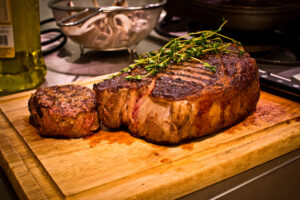 With the cost of beef soaring ridiculously higher by the day, eating a great steak at home is becoming a luxury. So, suppose you are “investing” in a prime ribeye, or any other of your favorite cuts, for that special occasion. In that case, it makes sense to prepare it perfectly. You do not have to be a gourmet chef to prepare a steak as good as any in those high-priced steakhouses. Also, you don’t need to use an expensive rib eye or filet mignon to enjoy a well-prepared streak that tastes great and doesn’t break the bank. I’ll have a list of cuts included on the online recipe page. Here are the simple preparation steps to impress your dinner guests and elevate your status as a culinary master.
With the cost of beef soaring ridiculously higher by the day, eating a great steak at home is becoming a luxury. So, suppose you are “investing” in a prime ribeye, or any other of your favorite cuts, for that special occasion. In that case, it makes sense to prepare it perfectly. You do not have to be a gourmet chef to prepare a steak as good as any in those high-priced steakhouses. Also, you don’t need to use an expensive rib eye or filet mignon to enjoy a well-prepared streak that tastes great and doesn’t break the bank. I’ll have a list of cuts included on the online recipe page. Here are the simple preparation steps to impress your dinner guests and elevate your status as a culinary master.
To be successful every time, you will need to do a bit of preplanning. Let’s start with three things you absolutely must have to be successful. I have included links to the most popular choices below.
3.) A wire baking sheet with a rack.
The following process is the same whether using a stove/oven or outdoor grill to prepare your steak.
Ingredients
- Steak of your choice
- Sea salt
- High smoke point oil (avocado or olive oil will work and are inexpensive)
- Ground pepper to taste
Let’s Get Started
First, we must prepare the star of the show for the performance. This begins 24 hours in advance of cooking. The steak must be salted and refrigerated for at least 4 hours, but 24 hours is ideal. This is done because we want to seal all the natural juices inside the meat. This method is the best way to do that. Salting the meat and putting it on a wire rack in the refrigerator for 4 to 24 hours will allow the salt to interact with the meat and seal the juices inside, making for a moist, delicious steak, regardless of the finished doneness. Please don’t skip this step. NEVER, NEVER, NEVER, EVER salt the beef immediately before putting it on a hot surface. This will draw the moisture from the meat, causing it to be dry.
Cooking
Remove the meat from the refrigerator. pat it dry with a paper towel and cover it with a clear plastic wrap. Let it sit for about an hour so it comes to room temperature. Preheat the oven to 400 degrees. Once the oven reaches temperature, turn the stovetop burner to high and set the pan on the burner. When the pan reaches 350 degrees, add enough oil to cover the pan lightly. Get your steak near the pan and set the timer on your phone for 2 minutes. When the oil reaches 350, this happens quickly, put the meat in the pan and start the timer. Do not move the meat! Let it stick to the pan. This is normal. It will be released when it is caramelized. This is known as the Maillard Reaction and enhances the flavor like nothing else. Don’t be in a hurry to move the steak. It will be released in about two minutes and is easy to flip.
Once you flip the steak, cook it for exactly one minute, but don’t disturb the meat. You might be tempted to lift the meat from the pan, but resist the urge and trust the process. Remove the pan from the burner at the one-minute mark and place it in the oven to finish cooking. Using your meat thermometer, let the meat cook to 5 degrees below your desired doneness. Remove it from the oven.
Resting
Place the pan on the counter and let it rest for 5-10 minutes. While resting, it will finish cooking and reach the perfect temperature for your desired doneness. You can check this fact with your meat thermometer, but the steak will increase in temperature by five degrees after removing it from the oven. Resting is a very important step and should not be rushed. Slice the steak against the grain either at the table or before serving. ENJOY!
Steak Temperature Guide
- Rare: 125-130 degrees
- Medium Rare: 130-135 degrees
- Medium: 140-145 degrees
- Medium Well: 150-160 degrees
- Well Done: Over 160 degrees